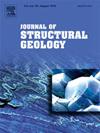Energy dissipation and fault dilation during intact-rock faulting
IF 2.6
2区 地球科学
Q2 GEOSCIENCES, MULTIDISCIPLINARY
引用次数: 0
Abstract
Rock-failure is usually analyzed by using the stress-based Coulomb criterion with the empirical parameters of cohesion and internal friction. We recently developed an alternative rock failure theory that is based on two conditions: rocks fail under a critical elastic energy threshold, and the applied elastic strain is accommodated by shear and dilation along the faults. We refer to this theory as Critical Energy Fault Failure (CEFF) and demonstrated its applicability to a range of rock failure experimental configurations from uniaxial to polyaxial loadings (Reches and Wetzler, 2022). In the present analysis, we utilized the energy-based CEFF theory to highlight further aspects of rock faulting: A. Evaluation of the dissipated energy associated with rock faulting which revealed that intact rock failure dissipates 35–55% of the available elastic energy. B. For a given normal stress, the CEFF calculated shear strength of a developing fault is smaller than the equivalent of the Coulomb shear strength. C. The predicted dilation associated with faulting of intact brittle rocks that is calculated by CEFF is supported by experimental observations. These three analyzed subjects provide important contributions for the understanding of rock failure processes.
完整岩体断裂过程中的能量耗散与断层扩张
岩石破坏分析通常采用基于应力的库仑准则,以黏聚力和内摩擦为经验参数。我们最近发展了一种替代岩石破坏理论,该理论基于两种条件:岩石在临界弹性能量阈值下破坏,外加的弹性应变由断层的剪切和扩张调节。我们将这一理论称为临界能量断层破坏(CEFF),并证明了其适用于从单轴到多轴载荷的一系列岩石破坏实验配置(Reches和Wetzler, 2022)。在目前的分析中,我们利用基于能量的CEFF理论来强调岩石断裂的进一步方面:A.与岩石断裂相关的耗散能量的评估,表明完整的岩石破坏耗散了35-55%的可用弹性能。B.对于给定的正应力,CEFF计算的发育断层的抗剪强度小于库仑抗剪强度的当量。C. CEFF计算的与完整脆性岩石断裂有关的膨胀预测得到了实验观测的支持。这三个分析对象为理解岩石破坏过程提供了重要的贡献。
本文章由计算机程序翻译,如有差异,请以英文原文为准。
求助全文
约1分钟内获得全文
求助全文
来源期刊

Journal of Structural Geology
地学-地球科学综合
CiteScore
6.00
自引率
19.40%
发文量
192
审稿时长
15.7 weeks
期刊介绍:
The Journal of Structural Geology publishes process-oriented investigations about structural geology using appropriate combinations of analog and digital field data, seismic reflection data, satellite-derived data, geometric analysis, kinematic analysis, laboratory experiments, computer visualizations, and analogue or numerical modelling on all scales. Contributions are encouraged to draw perspectives from rheology, rock mechanics, geophysics,metamorphism, sedimentology, petroleum geology, economic geology, geodynamics, planetary geology, tectonics and neotectonics to provide a more powerful understanding of deformation processes and systems. Given the visual nature of the discipline, supplementary materials that portray the data and analysis in 3-D or quasi 3-D manners, including the use of videos, and/or graphical abstracts can significantly strengthen the impact of contributions.
 求助内容:
求助内容: 应助结果提醒方式:
应助结果提醒方式:


